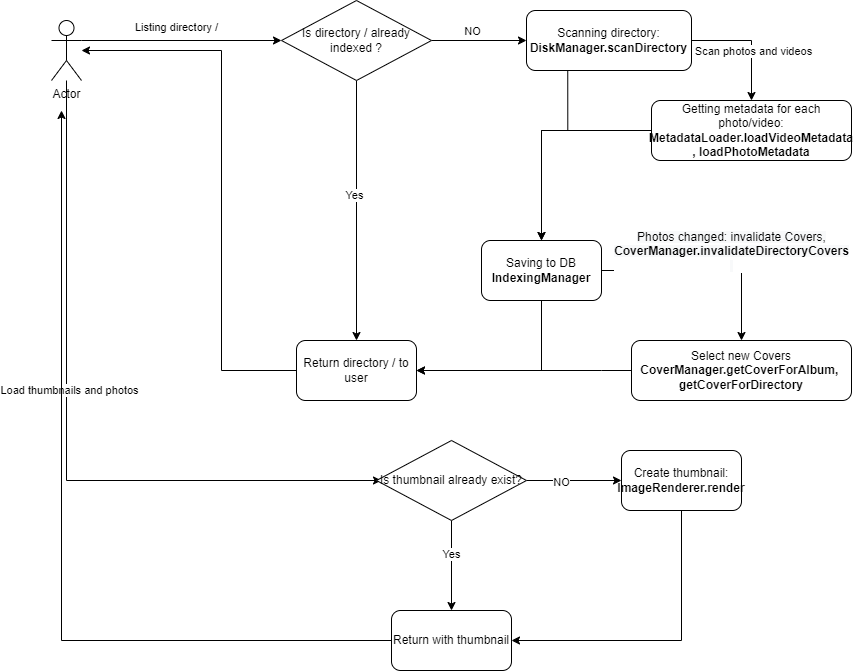pigallery2 Extension
See feature issue for more information: #743.
See sample extension at https://github.com/bpatrik/pigallery2-sample-extension.
Extension Usage
Extension folder can be set through config. For the docker-ised version,
they live under the config/extension folder in their own subdirectory.
Extension development
Minimal setup
You need at least a server.js in your extension folder that exports a init(ext) {} function.
Recommended setup
<path to the extension fodler>/myextension/package.js <- this is optional. You can add extra npm packages here
<path to the extension fodler>/myextension/server.js <- this is needed
Where <path to the extension fodler> is what you set in the config and myextension is the name of your extension.
Note: you do not need to add your node_modules folder. The app will call npm intall when initializing your extension.
Extension environment
The app runs the extension the following way:
- It reads all extensions in
<path to the extension fodler>/**folder - Checks if
package.jsis present. If yes installs the packages - Checks if
server.jsis present. If yes, calls theinitfunction.
Init and cleanup lifecycle
There is also a cleanUp function that you can implement in your extension.
The app can call your init and cleanUp functions any time.
Always calls the init first then cleanUp later.
Main use-case: init is called on app startup. cleanUp and init called later when there is a new config change.
Extension interface
The app calls the init and cleanUp function with a IExtensionObject object.
See https://github.com/bpatrik/pigallery2/blob/master/src/backend/model/extension/IExtension.ts for details.
IExtensionObject exposes lifecycle events, configs, RestAPis with some limitation.
Changes made during the these public apis you do not need to clean up in the cleanUp function.
App also exposes private _app object to provide access to low level API. Any changes made here needs clean up.
server.js
See sample server.js at https://github.com/bpatrik/pigallery2-sample-extension.
It is recommended to do the development in ts, so creating a server.ts.
Note: You need to manually transpile your server.ts file to server.js as the app does not do that for you.
This doc assumes you do the development in ts.
server.ts
You can import package from both the main app package.json and from your extension package.json.
To import packages from the main app, you import as usual.
For packages from the extension, you always need to write relative path. i.e.: prefix with ./node_modules
// Including dev-kit interfaces. It is not necessary, only helps development with types.
// You need to prefix them with ./node_modules
import {IExtensionObject} from './node_modules/pigallery2-extension-kit';
// Including prod extension packages. You need to prefix them with ./node_modules
// lodash does not have types
// eslint-disable-next-line @typescript-eslint/ban-ts-comment
// @ts-ignore
import * as _ from './node_modules/lodash';
// Importing packages that are available in the main app (listed in the packages.json in pigallery2)
import {Column, Entity, Index, PrimaryGeneratedColumn} from 'typeorm';
pigallery2 extension dev-kit
It is recommended to use the pigallery2-extension-kit node package.
npm install pigallery2-extension-kit --save to your extension.
pigallery2-extension-kit contains the type definitions and enums for the app.
This node package is basically includes the all definitions of the app and exports the IExtensionObject that the init function receives.
You can then import {IExtensionObject} from './node_modules/pigallery2-extension-kit';
See https://github.com/bpatrik/pigallery2/blob/master/src/backend/model/extension/IExtension.ts to understand what contains IExtensionObject.
NOTE: this is not needed to create an extension it only helps your IDE and your development. These type definitions are removed when you compile ts to js.
init function
You need to implement the init function for a working extension:
export const init = async (extension: IExtensionObject<void>): Promise<void> => {
}
pigallery2 lifecycle events
Tha app exposes multiple interfaces for the extensions to interact with the main app. events are one of the main interfaces.
Here are their flow:
